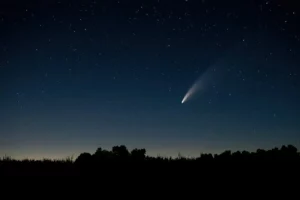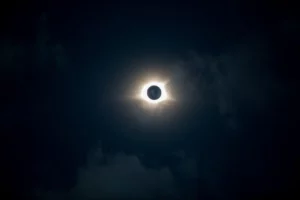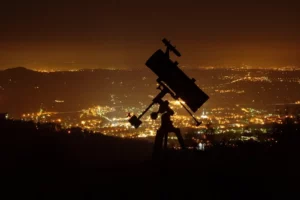
What is star hopping?
We live in the age of GO-TO telescopes. With only a push of a button, you travel from the Lunar neighborhood to the far reaches of deep space in just a few seconds.
Despite all of this easily available technology, many amateur astronomers do their observing without the use of GO TO telescopes, and some say that here resides the true joy of observing.
But how is it possible to find a dim galaxy or nebula lost among all those thousands of stars? Star hopping is the answer.
Star hopping is used whenever one intends to find a celestial object spreading a dim light, invisible to the naked eye. It consists of successive leaps from a star that is visible either with the naked eye or with a finder-scope, to another star and so forth until the aimed target is reached.
Before you go under the stars with a telescope, make sure you know some prominent bright stars and constellations. You will use them as a stepping-off point to find those constellations and stars that you don’t know.
Equipment
The equipment you need is pretty basic: a star atlas and a decent finder-scope attached to your telescope. The atlas of choice for beginners is Sky Atlas 2000, after you gain more experience a more comprehensive atlas like Uranometia 2000 will do better.
Sky Atlas 2000 indicates stars up to magnitude 8.5 and about 2500 deep sky objects. The scale of the maps is about 8 mm per degree. Knowing the scale will prove useful a little later when we determine the visual field of the eyepieces.
I recommend having every page of your atlas wrapped in a protective plastic sheet. Thus you will be able to draw lines joining the stars in a constellation, which will help you get orientated more easily. Besides, your atlas will be safe from moistness.
Determining visual fields
Once you have the atlas, the next step is to determine the visual field of the eyepiece you are using. One first method is used in case you know the apparent field of the eyepiece and its magnifying power when assembled to the telescope.
In order to determine the power given by the eyepiece, you should divide the focal length of the instrument by that of the eyepiece. If for example, we have an eyepiece with an apparent field of 50 degrees, which assembled to the telescope gives a power of 30x, then the visual field of the eyepiece will be equal to the apparent field divided by the magnifying power of the eyepiece, that is 50/30, which is about 1.7 degrees.
If you don’t know the apparent field of the eyepiece the matter becomes a little more complicated… In order to find out the visual field of the eyepiece in this particular case, you should direct the instrument to a star as close as possible to the celestial equator, set the star at the edge of the visual field and measure the time it takes for the star to cross the eyepiece, without moving the instrument. Knowing that a star near the celestial equator will move one degree every four minutes, you can calculate the visual field of the eyepiece.
Now that you know the visual field and the scale of the atlas you can make either wire or plastic rings that will represent the field. If the eyepiece has a visual field of two degrees and the scale of the atlas measures 8-mm per degree, the ring should have a diameter of 16-mm. The ring is extremely useful when the object to be localized is found in an area of the sky with very few stars, normally it is not used too often.
In order to find a celestial object with the star hopping method, the visual field of your eyepiece should be as large as possible, so don’t use great magnification. This way you will be able to see several stars in the field and will have reference points. Only when you have found the desired object should you use eyepieces with great magnifying power.
The finder-scope
The finder attached to the main instrument is also very important. It would be great to have a finder with an aperture as large as possible (50 mm would do best). With a six to seven-degree visual field, such a finder will point far more stars than visible with the naked eye, thus making it very easy to identify the area where the target is. You can determine the visual field of the finder with the help of methods described so far.
Coping with mirror or inverted images
According to the type of instrument you are using, the images will be either inverted or reversed (mirror image). Newtonian telescopes give an inverted image (north becomes south), while instruments with a diagonal (a small mirror) will give reversed images.
The solution every time you use a Newtonian telescope is simple: turn the maps upside down. The problem occurs with instruments using a diagonal. A solution is to flip over your sky chart and shine a light behind it to view a mirror image of the printing through the paper.
A little theory…
In order to start a star hopp the first step would be to identify on the atlas the area where your aimed object is. After this find a star, or a group of brighter stars visible with the naked eye and situated as close as possible to the target.
Without looking through the finder or telescope, with both eyes opened, look along the instrument and point it to the area of interest. The point is to centre in the finder, after having consulted the atlas, a group of stars that stand out among the rest. It is extremely important that this point of reference should fit into the visual field of the finder so that it may be recognized even if it is not centered perfectly.
The more difficult part is to memorize the shape of the pattern formed by the group of stars, in some cases you may need to return to the group after having passed by it. Confusion may occur in case you mistake a group for another, only to finally find yourself a few degrees away from the targeted object. The solution is to associate a familiar shape to a group of stars (line, triangle, circle or square), thus you will succeed in memorizing them more easily.
And the real thing. Star hopping exercise
M92 is a beautiful globular cluster in Hercules, about 26,000 light-years distant from Earth. It is an easy target even for small telescopes, and on clear nights it can be spotted with binoculars if you observe on a dark sky far from city lights.
For this star hopping example let’s say that your finder-scope’s field is five degrees and the eyepiece field is one degree. The large circle represents the field of the finder-scope and the small circle is the field of the eyepiece.
To get to M92 first locate the bright star Pi Herculis, shining at 3rd magnitude. Center it in the field of your finder-scope and sweep one more field, following the line drawn from Pi to Iota Herculis. At the edge of the field look for four stars arranged in a line, and center them in your eyepiece. Move one degree in the direction of Iota Herculis and M92 will be right in the center of your eyepiece.

Emil, an avid astronomy writer, formerly owned and ran nightskyinfo.com, making the universe more comprehensible for his readers. He has recently handed over its reins to Tom Urbain from starlust.org, ensuring that his legacy of simplifying the stars continues to enlighten and inspire.
Leran to navigate the night sky 🔭
This page is part of our collection of stargazing guides. If you enjoyed the read, then you’ll love the following articles.




